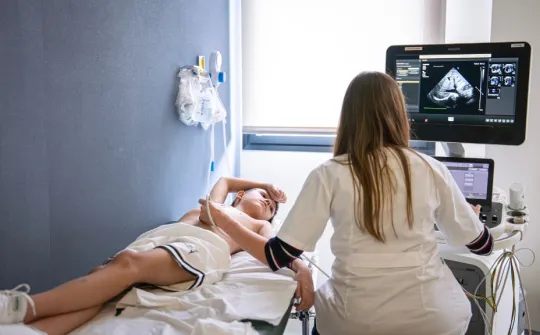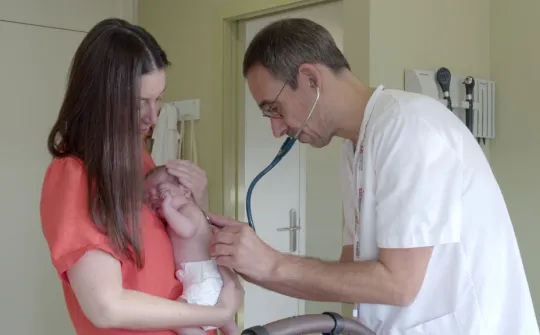
Interview with José Hinojosa Mena-Bernal, Head of the Neurosurgery Department of the SJD Barcelona Children's Hospital
At the end of his medical degree, Dr. José Hinojosa was already clear on two things: that he wanted to be a surgeon and that he had always been passionate about the central nervous system. So, going into neurosurgery came almost naturally to him. In 2018, he arrived at Hospital Sant Joan de Déu Barcelona as head of the Neurosurgery Department, after periods at various hospitals such as Ramón y Cajal, el 12 de Octubre, and Niño Jesús, all of them in Madrid. A trajectory of more than twenty years dedicated, as he likes to point out, to caring for little patients, but also for their families.
What was the challenge you set for yourself when you arrived at the Hospital Sant Joan de Déu?
I came to Sant Joan de Déu because I was attracted by the institution and by the centre's care project. It is important to have an institutional structure that supports the management of very complicated patients, with high-level referral units in different specialities and made up of great professionals. In addition, to be able to have technological support, which is essential in our discipline, which evolves very quickly and in which it is increasingly difficult to keep up to date. The Hospital Sant Joan de Déu has all this.
Tell us a little more about the neurosurgery team you lead.
Currently the team consists of seven surgeons. For me, the best thing is that they are not only great professionals, but great people who make my job very simple. The team is a specialist one in all areas of paediatric neurosurgery, we can handle all paediatric neurosurgical pathology, which includes several sub-specialities. However, there are certain areas in which we are a worldwide reference point: neuro-oncology, functional surgery, which includes epilepsy surgery and deep brain stimulation; congenital malformations, including the tethered cord and, also, craniofacial surgery.
In 2019 you managed to operate on a child for a hamartoma for the first time in Spain using the thermal laser ablation technique. What has this achievement meant for the team?
Obviously a great satisfaction because this means greatly reducing the risk of sequelae for patients. Thermal laser ablation is a surgical technique that is minimally invasive and very effective, and is used mainly for small tumours and to ablate the focus, which is the cause of some refractory epilepsies, those that do not respond to medication. It of course requires great planning because it involves many professionals from different specialities and, without a doubt, it requires the effort of an entire institution that is committed to having everything necessary, both technological and human, to be able to carry out a technique of this complexity.
How important is technology now in neurosurgery?
It is vital. Because of it, today we can treat patients that we previously ruled out due to the risks of sequelae or due to the technical difficulty involved. It is true that, in an intervention such as thermal laser ablation, the robot replaces much of the surgeon's expertise, but where skill is essential is in the programming prior to said intervention: where are we going to put that millimetric fibre, by which route are we going to get it to the focus, what healthy structures can we cross without causing an injury ... and this can only be done by a surgeon. Undoubtedly, the greater “surgical library” a surgeon has in his knowledge, the better use he will be able to make of all the technological advances.
And speaking of the importance of technology, what has it meant to have an intraoperative MRI thanks, specifically, to the donation of the Anita Charitable Association?
As a team leader, it is a great responsibility for me. First of all, from the point of view of the safety of the patient and the human team. It is an irreplaceable tool due to its performance and effectiveness, the use of intraoperative magnetic resonance requires compliance with strict safety protocols. The second point of responsibility is to be aware that we must make the most of the great financial effort made by the donors of the MRI and the new surgical block, and our institution. We must be at the highest level as a team.
Magnetic resonance imaging is a before and after in the “therapeutic arsenal” of neurosurgery. It allows us to perform surgeries by observing the behaviour of the brain in real time; to improve the removal of tumours and, therefore, increase the survival of our patients, reducing the appearance of sequelae; and confirm the efficacy of our technique in cases of epilepsy surgery or brain stimulation. It is also very useful for developing research projects in such exciting fields as oncology, brain neuromodulation or neural networks.
How do you see the future of neurosurgery in Sant Joan de Déu?
I see a consolidation of the work done so far, giving the best guarantees of effectiveness, efficiency and safety for the patient. The future of operating theatres and neurosurgery in particular will go hand in hand with artificial intelligence: augmented reality and its derivatives are already today a development tool in our speciality. My dream as a surgeon is to achieve equal access to health systems. For everyone one day to have the same opportunities for treatment and healing, regardless of where they were born.
Today, what do your patients mean to you?
When you start in your profession, you are very young, and each patient is a “clinical case”. Over the years these patients are incorporated into the book of your life. They and their families, with their personal stories, become part of you. I still keep in contact with patients I operated on 25 years ago: those children, today men and women, and their families are still very present and it is incredible to continue receiving their messages for Christmas or on my birthday. Some still write to me on their second birthday: their parents told them that their new life began the day I operated on them.
In each MRI of an oncology patient, I no longer see just a tumour ... I see a whole family. I think before each procedure how my actions will influence them for the rest of their lives, and how I will have to support them when complications arise. The surgery does not end when I leave the operating room.



